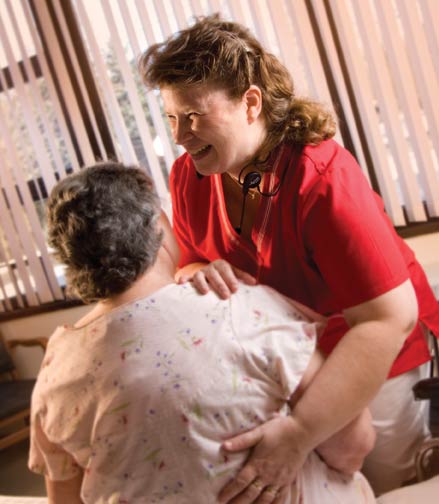 When one thinks of warehouses, health care probably is not the first thing that comes to mind. But a technology that began in supply-chain management has made its way to long term care, and providers are utilizing it to improve resident care and ease documentation. Known as voice-assisted technology, it first landed in long term care, but has since expanded into acute care.
When one thinks of warehouses, health care probably is not the first thing that comes to mind. But a technology that began in supply-chain management has made its way to long term care, and providers are utilizing it to improve resident care and ease documentation. Known as voice-assisted technology, it first landed in long term care, but has since expanded into acute care.
Voice-assisted technology is typically utilized by caregivers who are equipped with personal headsets designed to recognize voice commands and provide detailed information. Each headset is wirelessly networked to a central computer system that records and stores the information. The technology allows its users to hear individual residents’ personalized care plans, to silently page other staff members for assistance, and to document care tasks, all through the headset and without having to access paper records.
Proponents of the technology say that it helps staff deliver person-centered care profitably, simply by talking and listening.
During the American Health Care Association/National Center for Assisted Living 60th Annual Convention & Expo, held in Chicago in Oct. 2009, executives from several long term care companies participated in a panel discussion about how voice-assisted technology is helping them improve resident care, facility operations, and revenue.
In particular, improvements include better financial performance of six and seven figures per facility, higher resident and family satisfaction through better clinical outcomes, better survey results and compliance, and improved communication across care delivery teams.
Caregiving Benefits
Caregivers benefited from dramatically improved communication across delivery teams, the panelists reported. Because documentation is completed as the user speaks into the headset, there is no lag time and no guesswork in charting, providers reported.
This saves time and eliminates copycat charting, which is a major problem in traditional documentation systems.
One panelist tested several documentation systems before making the investment in one. A remote wireless voice-activated system simplified documentation for the nurse assistants better than another system that required the use of a computer to “convert their actions into documentation.”
The investments required to set up the system included renting the equipment and fitting the facilities for wireless capability.
The ease of use and immediacy of voice-assisted technology also gives team members quick, simple access to accurate, updated records and care plans for residents. This, in turn, increases survey results and compliance, another challenging area for facilities using other forms of documentation.
When a panelist was in jeopardy of being written up by a surveyor because the care plan had not been updated, a staff member spoke up and suggested they take a look at the voice-assisted system. “A care plan isn’t just necessarily that piece of paper in the chart that no one looks at, when in fact, [the technology] drives the care plan out to the end users,” he said. The surveyor agreed, and the provider was able to demonstrate that they had, in fact, actually modified a care plan to meet the needs of this resident. “We had been providing the right care, and it had been documented. And so she didn’t cite us.”
Preferred Care Partners Management Group, Plano, Texas, which represents 66 communities in Texas, Arizona, Florida, Iowa, and Kansas, reported that after piloting a voice-assisted system in two buildings, the average activities of daily living score increased from 11 to 15.65.
Others reported that its silent paging feature increases staff efficiency by enabling them to page one another for assistance right from the resident’s bedside. This eliminates the need for staff members to leave a resident unattended while they physically go to look for help in lifting a resident or administering medication.
In addition to streamlining work processes and increasing efficiencies, the silent paging feature eliminates noisy, disruptive overhead announcements and pages, thus creating a more peaceful environment inside the facility.
The panelists reported that voice-assisted technology brought with it unexpected benefits, such as improved teamwork, a new sense of pride, and increased levels of professionalism among the staff.
Executives found that since team members at every level needed to learn how to use the technology together, a collaborative bond developed among the whole staff. They also reported improved communication among staff members, which translates into a better working and better care environment.
Revenue Boosted
Increasing reimbursement and reducing operating costs are two challenges facing nearly all long term care facilities. The idea of implementing a new charting and communication system, with its requisite technology needs, initially may seem overwhelming and cost-prohibitive.
However, facilities that have implemented voice-assisted technology reported that just the opposite is true. In fact, the cost savings for operators is profound, with many facilities showing superior financial performance of six or seven figures in each building after implementing the technology.
The technology helps to save costs and increase revenue in several ways, providers reported. First, it increases facility revenue by enabling more thorough and complete documentation, which results in higher reimbursement.
One provider with 10 communities reported an increase of $5.00 per day in its Medicaid rate and an increase of $50.00 per day in its Medicare rate after implementing voice-assisted technology. When these increases were annualized for one building, they equaled more than $1 million of additional reimbursement compared with the previous year.

Another provider suggested that the implementation of the system is helping them capture the services that are actually rendered. “Nurse aides sit down and spend all their time writing little initials in little boxes on flow sheets for 30 minutes or an hour out of their seven-and-a-half-hour day,” one panelist said. “And those things are not accurate…but if the nurse aide only has to communicate, this is a tremendous system. They use this little tiny headset, and it captures all that wonderful information in 1.6 seconds or something like that. You can’t help but win.”
Voice-assisted technology can also reduce or eliminate the need for overtime shifts. One company reported that its overtime shifts practically disappeared.
The decrease is the result of employees using voice-assisted technology to chart as they go, which eliminates time spent completing paper forms or waiting to access another type of documentation system.
Click
HERE for tips on how to implement voice-assisted technology.
Susan LupPlace is director of clinical services at Preferred Care Partners Management Group, Plano, Texas; Troy Baumann is chief operating officer of Community Eldercare Services, Tupelo, Miss.; and Jim Quasey is president of Vocollect Healthcare Systems, Pittsburgh.